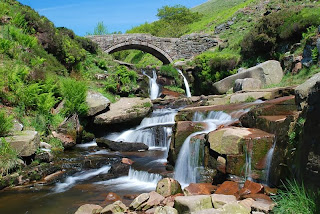The theme of Holocaust Memorial Day
on January 27th year will be “Journeys”. The Memorial Day originated in 2001
with the aim of remembering the crimes, racism and victimisation committed
during the Holocaust are neither forgotten nor repeated, whether in Europe or elsewhere in the world. It has been
commemorated every year since.
The young woman whose picture that
looks out at the reader is Ruth Schmerler whose journey began when she left her
home in Poland as a 14 year
old in 1939 moved to a home in Manchester
for Jewish Refugee Children with her brother Klaus. Her family had lived for
generations in Galicia in Poland . Ruth
worked as a Land Girl picking fruit in Worcestershire. She was found murdered
her body found at Counslow in late September 1944 on the Alton-Cheadle road. She
was 20 years of age, her journey had ended.
She was last seen receiving a lift
from an Army vehicle at Selly Oak in Birmingham
on 21st September. She was intending to see her brother in Manchester who was
working as an optician’s assistant. When her body was discovered she had been
stabbed as well as an attempt made to strangle her. Her clothes were
disarranged and a stocking was missing. Robbery was not thought to be a motive.
Ruth’s suitcase and other belongings were found 150 miles away at Shap Fell in Cumbria . Her
murder was unsolved despite the best efforts of the Cheadle police. It was the
first case that mine detectors were used in a vain attempt to find the weapon
that killed Ruth.
Ruth’s story is a poignant one. She
escaped the persecution of the Nazis who had killed all her relatives in Poland ,
for her to die brutally and her body to be thrown into a Staffordshire ditch.
Her story is just one of the many millions of people who were forced from
homelands where communities had lived for hundreds of years to be either killed
or resettled distances away from their birthplace. The Jewish community of
Eastern Europe ceased to exist and cities which had sizable minorities such as Prague , Warsaw and Lvov were entirely purged.
Only 150,000 Polish Jews survived out of a population of over 3 million by 1945.
After the war vast movements of populations occurred. Tony Judt in his seminal
book on Europe “ Postwar” estimated that over 30 million people were
dispossessed from 1939 to 1950 including 11 million Germans, millions in the
Soviet Union such as the Crimea Tartars thought to be enemies of the state,
Poles, Hungarians, Italians and many other groups in a massive attempt at
“homogenising” vast swathes of the continent. Many Jews moved to the new state
of Israel , but also to
unbelievably escape further persecution in Eastern Europe
. Some of the displaced people of Europe found homes in England as the
Polish community at Blackshaw Moor testifies.
Writing about a massacre of Jews
that took place in Stryl in Galicia
in the summer of 1943 Schaje Schmerler concluded with this prayer. “Their
extinguished souls that ascended to heaven and were transformed into stars
shine now together will the souls of all those unlucky Jews martyred-- al
kiddush hashem --they shine down on us lest we forget what was done to our
people”.
Ruth Schmerler lies in a Jewish
cemetery in Manchester .
Perhaps some passer-by can say Kaddish for her and her people?






